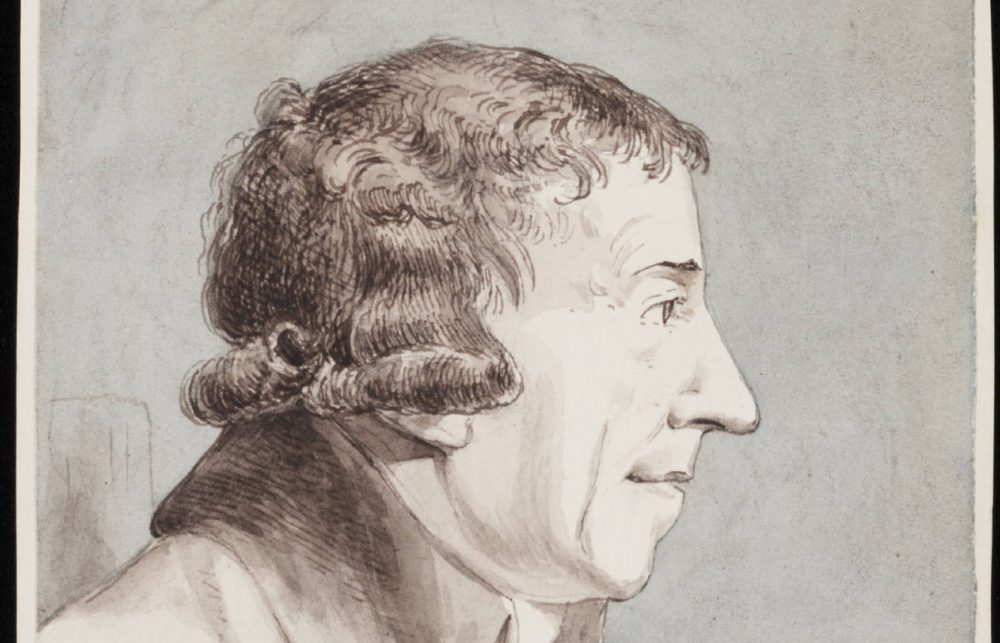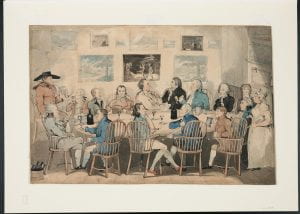Choice 22: Lord George Gordon at Newgate by Richard Newton
by Wilmarth S. Lewis
“After editing the Yale Edition of Horace Wapole’s Correspondence it was clear we needed a collection of eighteenth-century satirical prints and drawings. Their artists are the photographers of the time who show us its streets and rooms and the tacit assumptions of everyday life. I said to Annie Burr: ‘Study of satirical prints and drawings is a virtually unexplored continent and our print room could be its capital.'”
Lewis provides a history of the collection, its housing and acquisition. He describes the transformation of the old squash court at his Farmington home into a print room as well as the large painting that adorned one end, The Golden Asses by Thomas Patch. He lists the prints and drawings framed and hung on the walls and tells an anecdote about how he was given one as a gift by the Philadelphia collector Dr. Rosenbach.
“My brother-in-law, Hugh D. Auchincloss, gave to Yale his great collection of nearly 5000 English caricatures for our new print room, and another superb gift of 1,700 caricatures was given Yale for us by Augustus P. Loring of Boston. It is the major portion of the collection formed by his grandfather, Alfred Bowditch, who was one of the first in this country to see the importance of eighteenth-century satirical prints. He added learned and beautifully written notes on the mats. Gus Loring, a loyal Harvard man and member of the Walpole Society, gave the collection to Yale for Farmington because he believed that it would be more useful here than elsewhere. No such gift was ever made more generously, for Gus emphasized that the new owners were free to sell or trade any of the prints to strengthen the collection. Walpole’s blessing on this gift was revealed when four of the prints turned out to have his annotations. George Suckling, the London printseller, let me have the bulk of his eighteenth-century caricatures. Other consignments of over 1000 prints came from Maggs and The Old Print Shop in New York. These en bloc accessions put us on a par with the British Museum’s collection of English satirical prints from 1740 to 1800.
“Yale transferred to Farmington the print collection of many thousand portraits, country houses, and views of London that had been given to the University Library by Joseph Verner Reed who applauded the transfer. ” Lewis also recounts the addition of a new print room in Farmington.
He goes on to recollect his acquisition of a book dedicated to Lord George Gordon, “the instigator of the ‘Gordon Riots’ in 1780” and the doorway to Walpole’s Berkeley Square house with “the iron bars Walpole added to its front door during the Gordon Riots.”
‘In our print room is one of the twenty-six choices the Almighty is allowing me to save, a water-color drawing by Richard Newton of Lord George Gordon entertaining fifteen fellow-political prisoners in his dining-room on ‘he Master’s side’ at Newgate Prison where the privileged prisoners had their private quarters. He is wearing the beard he grew after he became a Jew and is seated on a dais above his socially inferior guests t one end of the table. He and all but three of them are smoking clay pipes, a defiance of contemporary manners as striking as going to a formal dinner-party today in blue jeans. You could not be more avant-garde than Lord George Gordon and his friends.”
“Most librarians in 1929 believed that the place for prints and drawings was in a museum, not a library; nor did many scholars, other than art historians, pay serious attention to them. In 1929 R.W. Chapman of Oxford stared with disgust at our drawing of Lord George. “Why,” he asked, “did you buy that horrible thing?” It is different today. When Andrew Wilton, then of the British Museum and now at Yale, saw the drawing he burst out, “Why, that’s a Newton!‘ And when Charles Montgomery, Curator of the Garvan and Related Collections of American Art at Yale, saw it he was astonished that it had so many Windsor chairs with such curious stretchers and induced the Registrar of Winterthur Museum, who was writing on Windsor chairs, to make a trip to Farmington to see them. Prints and drawings are documents that have messages for those who can read them.”
Lewis turns his attention to debates about the identification of the subject of a painting and the writing of an iconography of Walpole. The subject of iconography leads to an explanation of why Annie Burr Lewis was appointed Curator of Prints in the Lewis Walpole Library, and Lewis provides an account of the history of the print room, a discussion of prints, and enthusiastic statistics on print cataloging. He concludes:
“To help scholars explore the virtually unknown continent of English eighteenth-century satires, we shall reproduce photographically the 1200 in our library from 1740-1800 that are not described in the British Museum’s Catalogue of Political and Personal Satires. We shall then avoid the costly drudgery of writing descriptions that inevitably overlook details of interest to specialists–such as the Windsor chairs at Lord George Gordon’s dinner-party. I believe the twenty-first century will find our print room the busiest part of the Library, that more rooms will have been added to it, and that its contents will continue to be studies by visitors from all over the world.”
Lewis, Wilmarth S. Rescuing Horace Walpole. New Haven and London: Yale University Press, 1978.
To see the full chapter from Rescuing Horace Walpole called “Choice 22: Lord George Gordon at Newgate by Richard Newton” download or expand the link here:
 Loading...
Loading...
N.B. The collection of eighteenth- and early nineteenth-century British satires in the LWL’s collection have been cataloged in Orbis, Yale’s online library catalog, and through the Quicksearch Books+ interface, and digital images can be found in the Digital Collection.

